Part 3: Caçando em Solidão

Meanwhile, in Real!Portugal...
The closest thing we can think of as an "ancient" Portuguese people were known as Lusitanians. The Lusitanians were part of a first Carthaginian, later Roman series of client states spread out over the westernmost parts of the Iberian peninsula. Their population thus included people from Rome, Greece, northern Africa, and the British Isles, notably Celts.
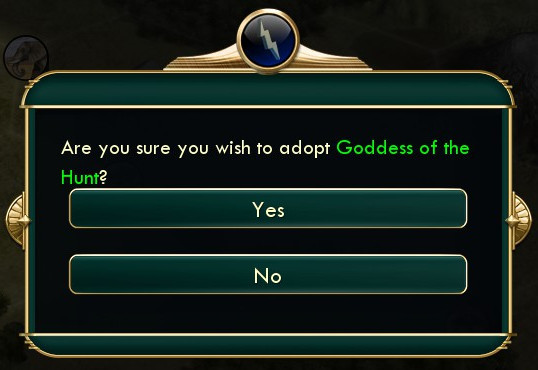
The Celtic peoples' influence over the Lusitanians included some shared religious iconography and nomenclature. The Lusitanians apparently propitiated their gods with animal sacrifices, and used basic sculpting techniques to represent their gods visually. There is a pantheon of Lusitanian gods specifically identified as such in old Roman texts, and some of the gods' names and functions are identical to ones in pre-Roman Celtic myths. Though a broad pantheon of names has been identified, some of the information about specific gods or their domains has been lost...
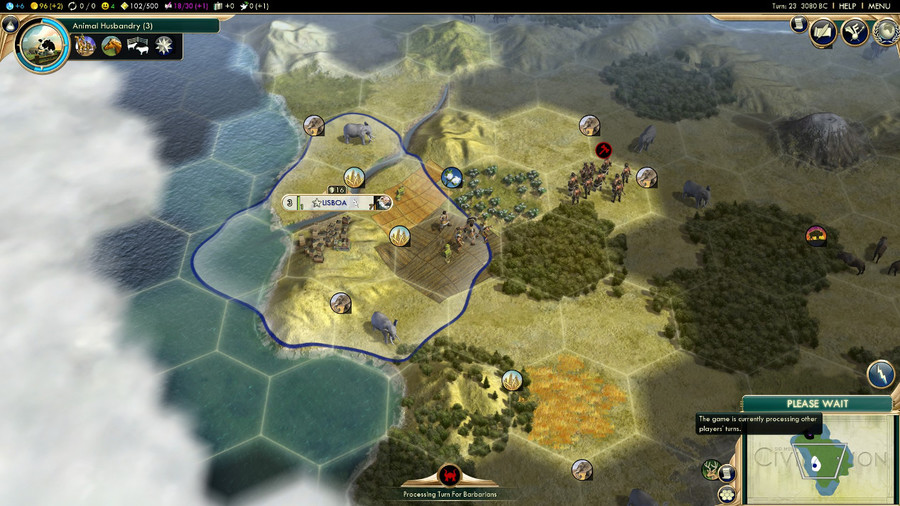
When we end our turn, the mostly-defeated Barbarian Brute makes a suicidal rush for our remaining Warrior, and is destroyed. However, his backup arrives very shortly thereafter and I can see that we may be in need of some support ourselves.
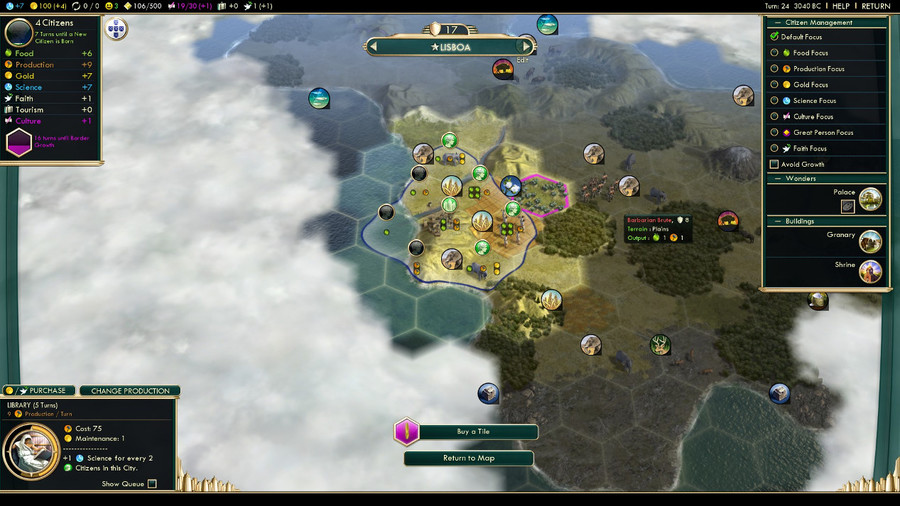
On the plus side, our second Farm finishes and Lisboa is making good progress on the Library and increasing its citizen population.

Yet, we stand to still lose a lot of future progress if our Worker is captured, so we move it back towards the coast where it could potentially start work on another (less immediately profitable) Farm. Our Warrior will move one tile northwest and fortify their position to hopefully gain a defensive bonus against an incoming attack.
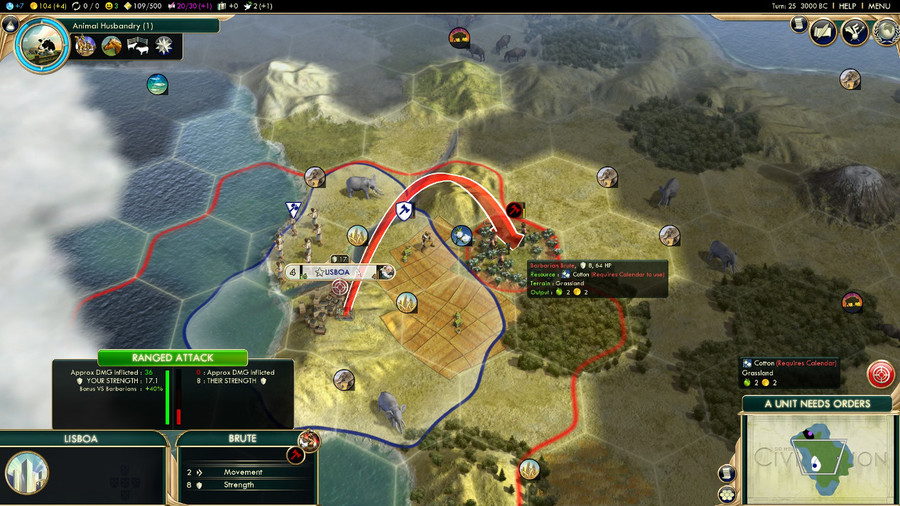
The Brute moves in and deals significant damage to the Warrior, leaving it at death's door. Lisboa can fire back...
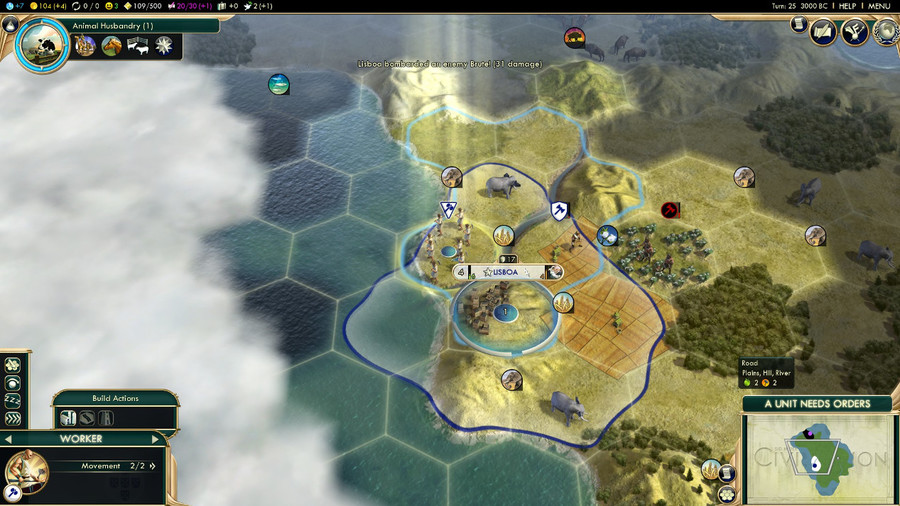
...but the Brute remains standing, even if heavily damaged. The issue now is that both the Brute and the Warrior are severely damaged and either one could die if I attempt to engage now. I could leave the unit fortified in its position and heal a bit for one turn, but I am not comfortable with the risk of the Brute attacking again and getting a lucky result on RNG, so I decide to move it and the Worker back into Lisboa to avoid a worst-case scenario.

The Warrior fortifies inside the city, which is helpful in that units heal more quickly inside Cities proper. I then await reprisal.
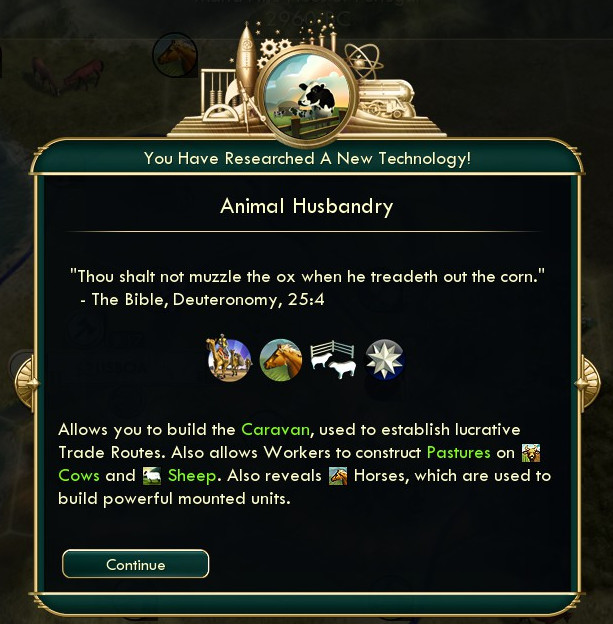
Oh, that's nice.
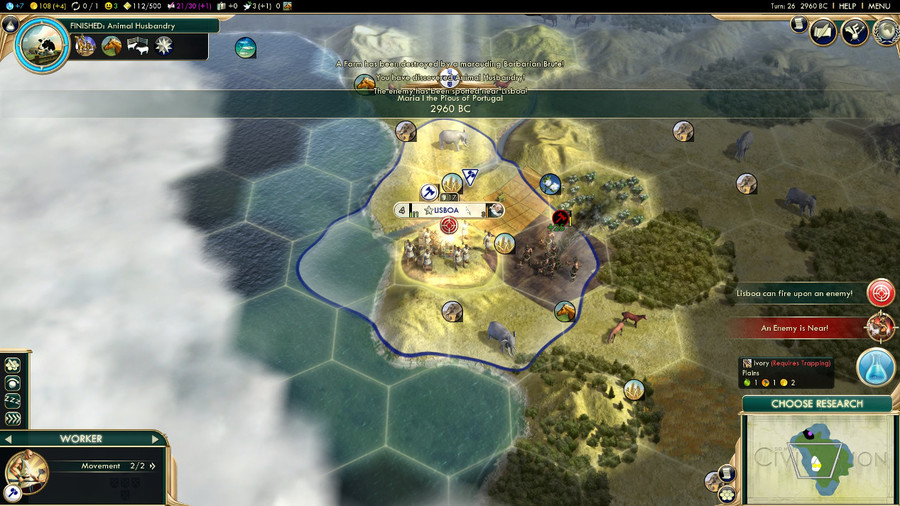
The Brute has moved in and the results are irritating. The Brute has spent a movement point to pillage one of the Wheat farms, which functionally cancels out the effects of the Tile Improvement and heals the Brute a noticeable amount. Were we to do this in an enemy Civ, we would also take some money from the ruined tile. Furthermore, a hostile unit standing on a tile inside our borders means the tile cannot be worked, so our food intake has been slashed significantly.
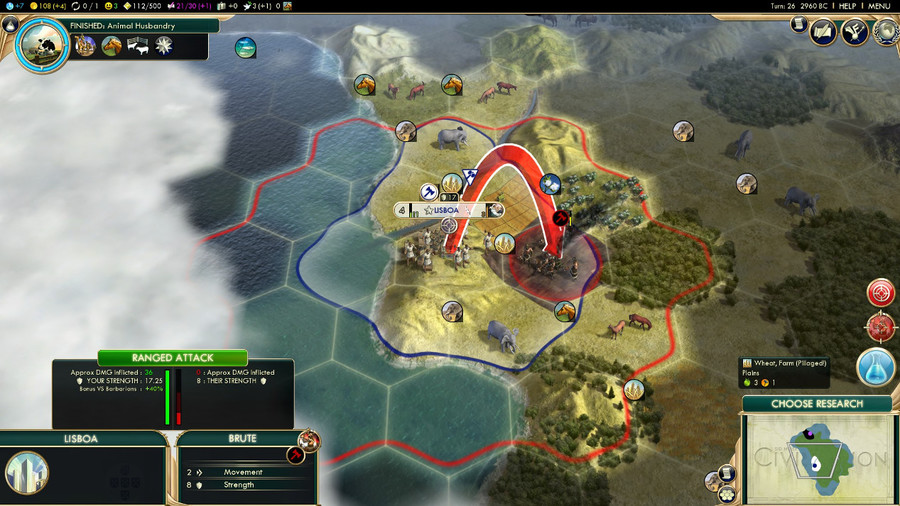
This will not stand.
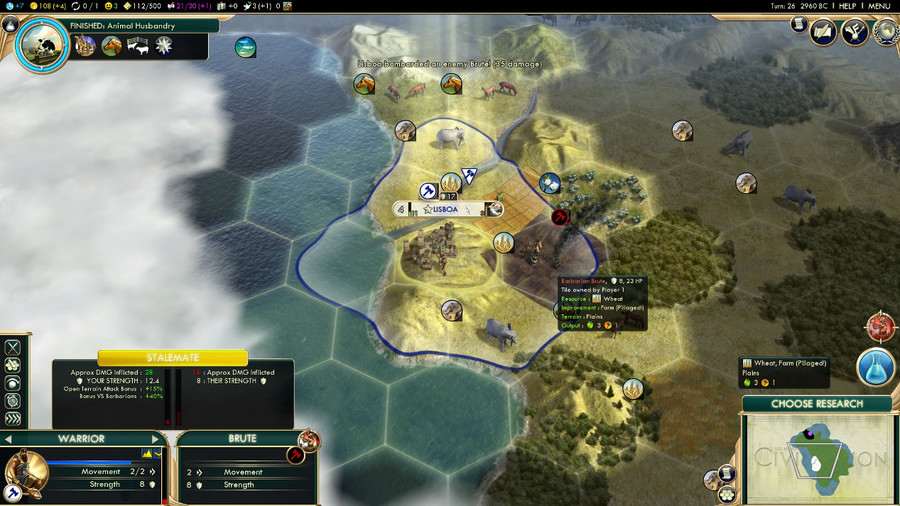
Again the Brute survives, and again it is a coin flip as to which unit dies if I try to engage it now. We pass the turn...
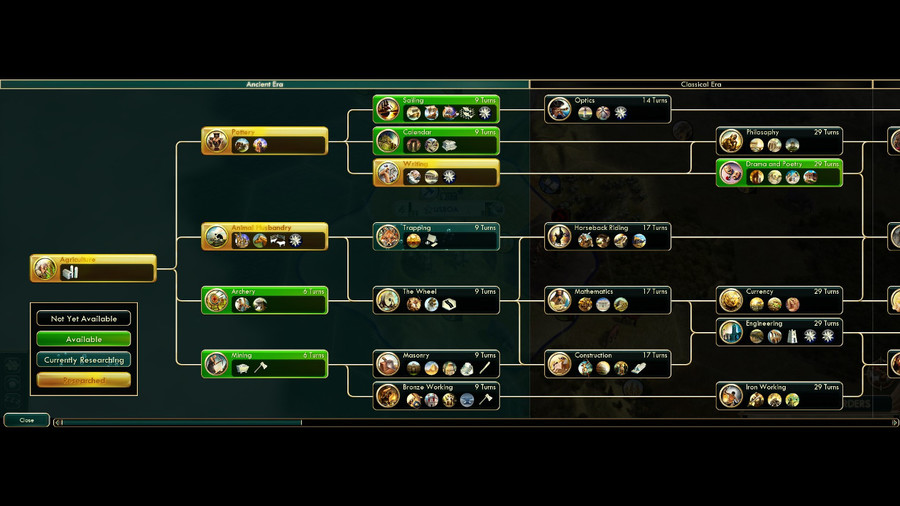
...though not before acceding to Dona Maria's demand to begin the Ivory harvest.
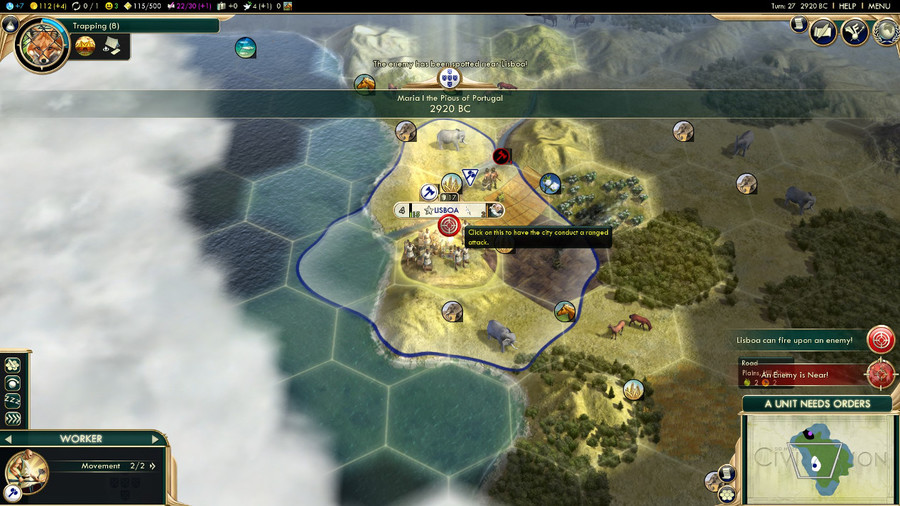
The Brute can only take one step due to Zone of Control, meaning that it has no available actions left to Pillage the other farm. The time has come.
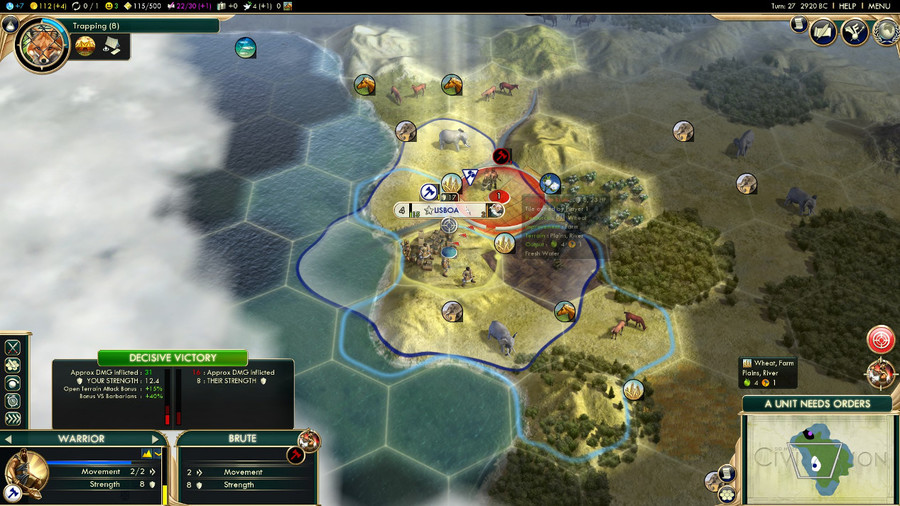
Our Warrior takes to the hunt!
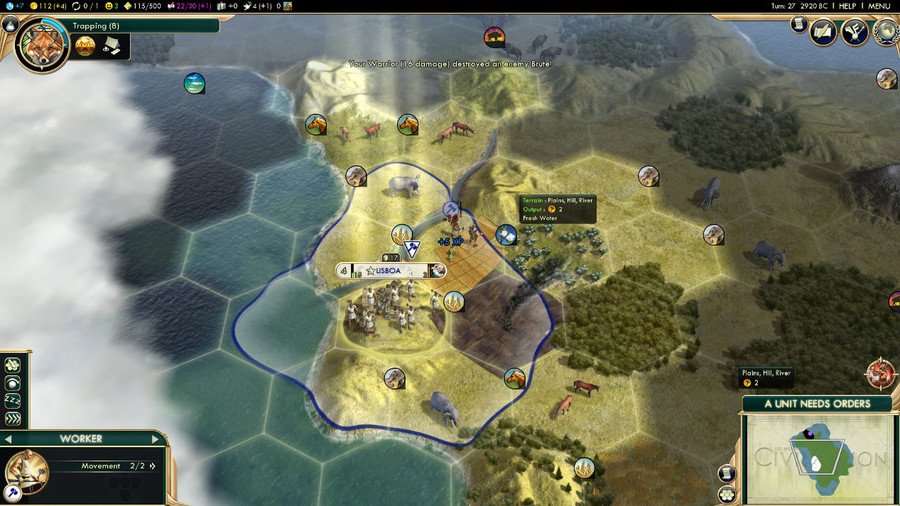
The results are clear to all. The Brutes scatter, and the surviving captives are executed by elephant.
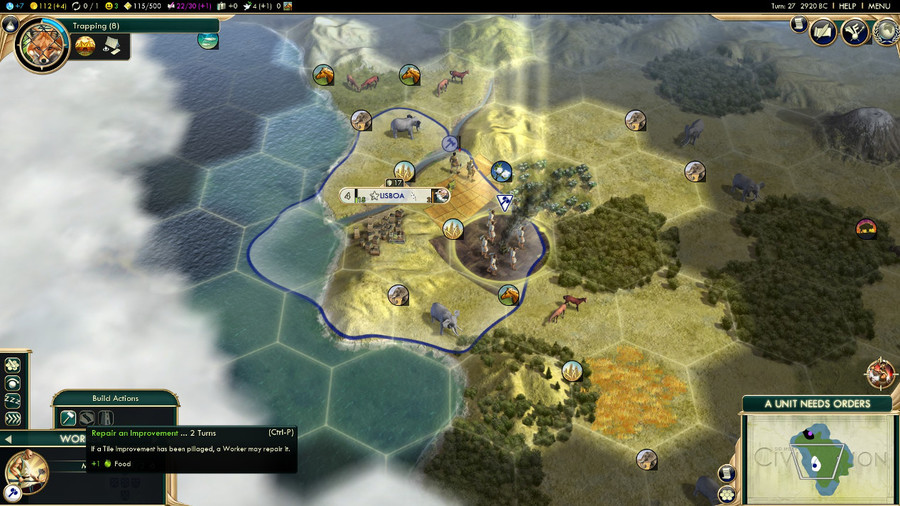
The Worker then begins reconstruction of the pillaged Farm. A Pillaged tile can be repaired by a Worker, and the action of repairing costs fewer turns than building from scratch, since the underlying infrastructure is still there, just damaged.
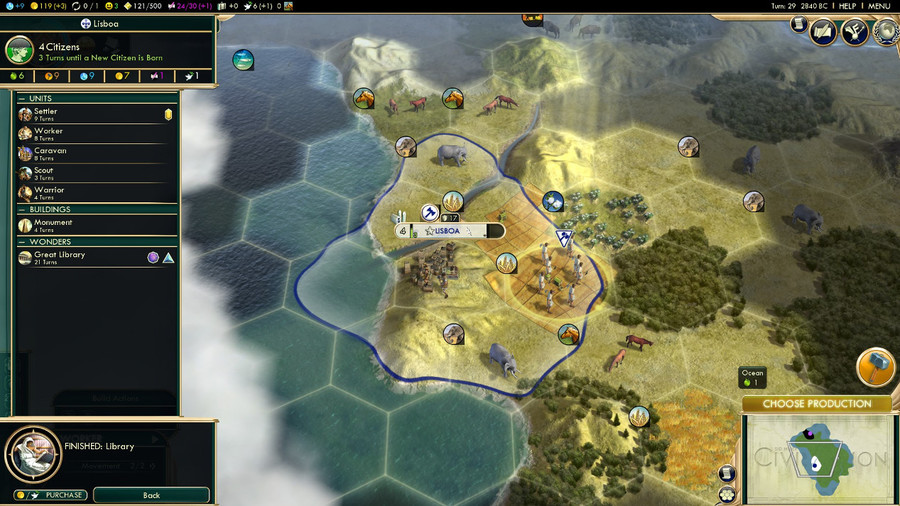
Two turns pass for repairing the Farm and getting the Warrior back in Lisboa to heal their wounds, and I decide to bolster our military by building a second Warrior to support the first. However, it is at this point that I take note of something very nice indeed. Our researching Animal Husbandry has revealed Horses around Lisboa, and in this case we have three separate tiles of them within potential Working distance. Lisboa's citizenry can work tiles up to three away from the City proper, and Horses are an excellent early-game boon to have since they boost Production and are used as Strategic Resources to create certain military units.
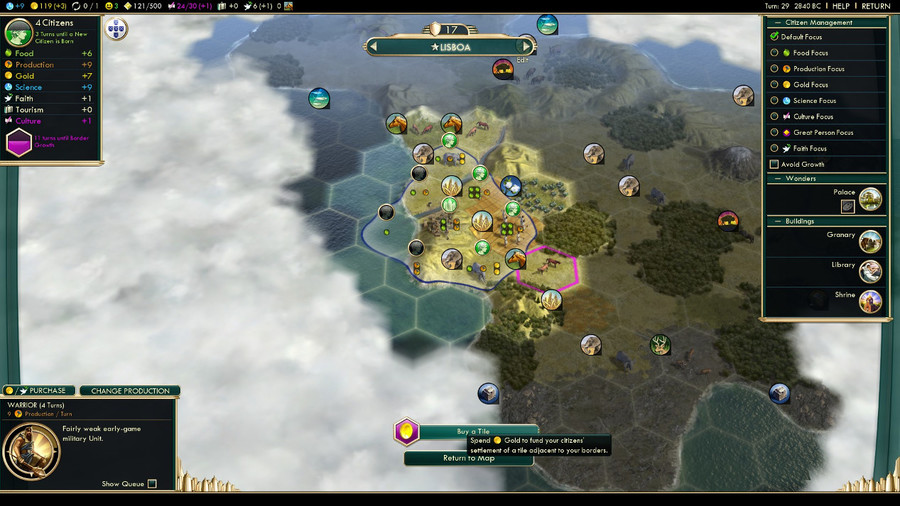
The issue is that the Horses can only be worked if they are within the borders of Lisboa, and we are not gaining Culture very quickly. a look at the city screen tells us that we will not be able to even begin construction of the Tile Improvement for another 11 turns. This is sub-optimal to say the least, so I decide to take a shortcut.

By clicking "Buy a Tile" towards the bottom of the City screen, we bring up a new overlay enabling us to pay Gold to increase the size of Lisboa's border. The tile costs are based on terrain type, and tiles with Resources tend to be cheaper than those without. The cost of buying tiles goes up each time you do so, therefore it is more sensible to be sparing when choosing to buy tiles early, and do so only when you have the ability to act on your purchase immediately.
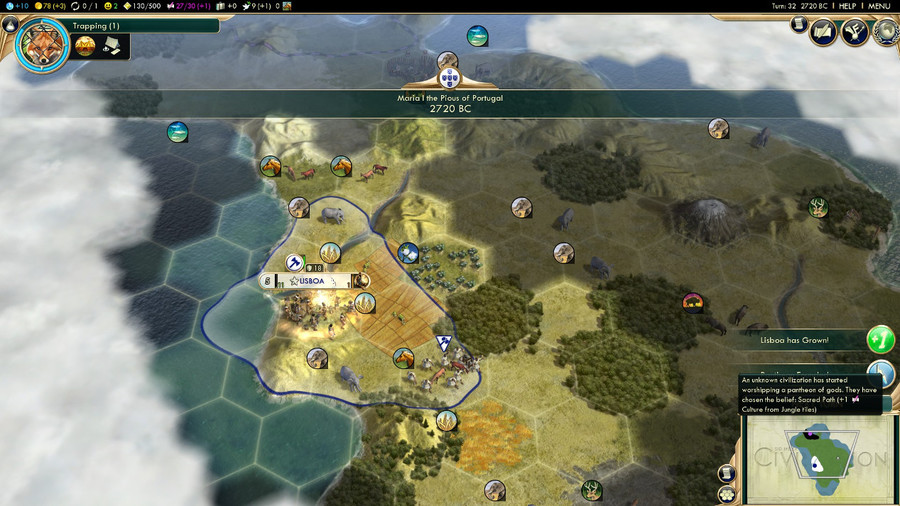
We are able to act immediately, so we move the freed-up Worker to start building a Pasture to corral the Horses. A Pasture will improve the Production value of the tile by 1, and give us access to 2 units of Horses to be used as Strategic Resources.
Also of note, to the right you can see the notification that somewhere, another Civ has formed a Pantheon and chosen the Sacred Path bonus, meaning that a potential Jungle-dwelling Civilization is on this map. I think people in the thread will hope for Montezuma of the Aztecs, but I personally hope it's Pedro for dynastic hilarity reasons.
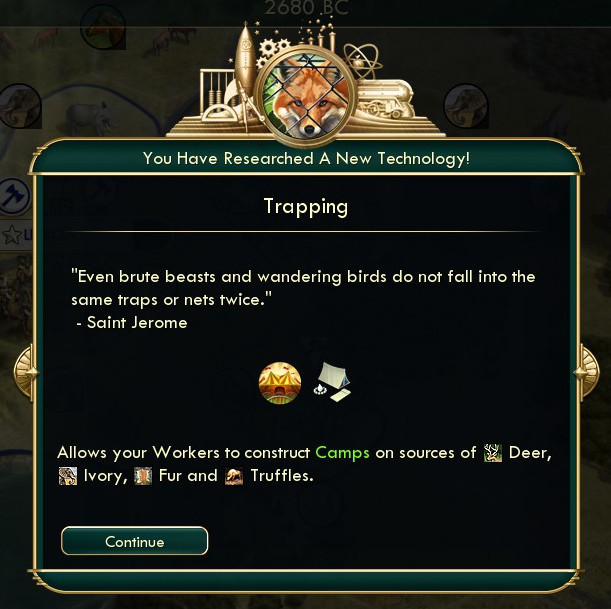
One more turn and it is time to begin the hunt in earnest. However, our Worker will be occupied for a few more turns with horses, thus we keep the secrets of elephant harvesting to ourselves for now.
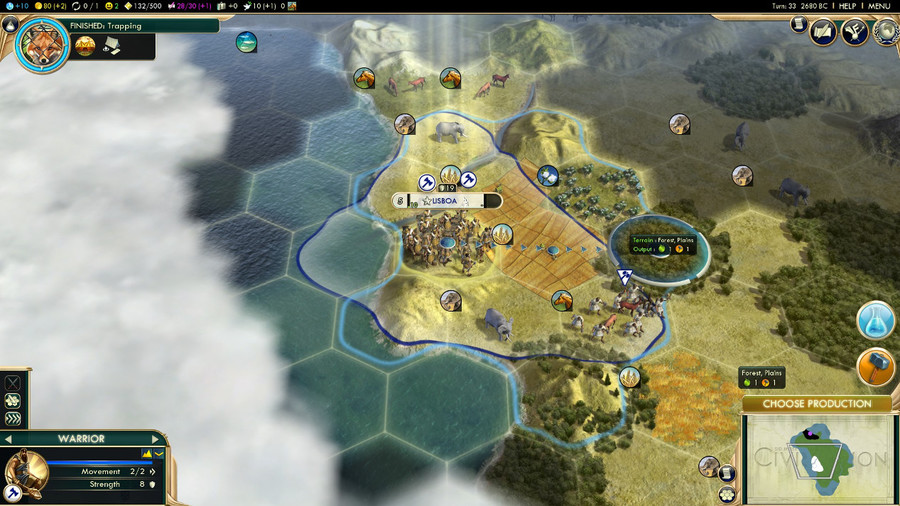
The second Warrior unit of Lisboa is completed, and we see the only circumstance in this game where two Land-based military units can occupy the same space at the same time. However, the game will force us to separate them before the turn ends, so we move our more experienced one directly east...
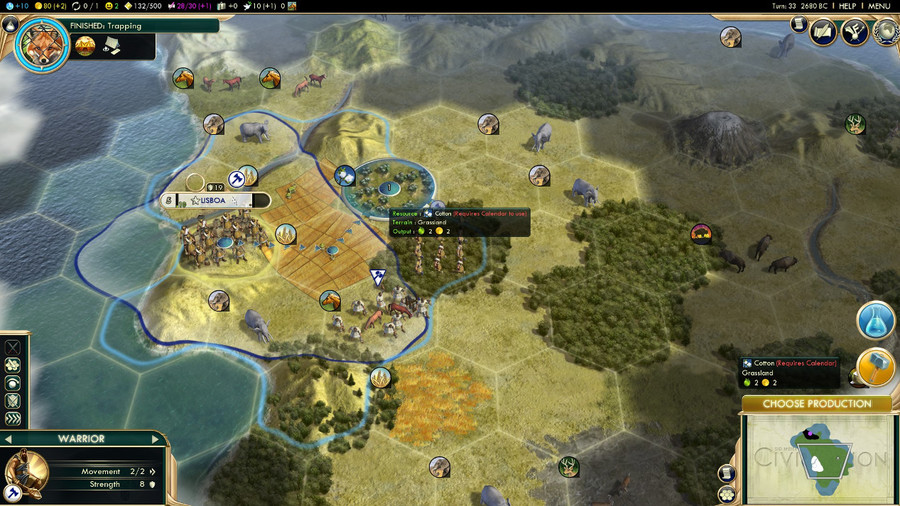
...and move the rookie Warrior one space northwest from them. This way, if they both make moves directly east to scout, the former will not be slowed by the forest tile, and the latter will pass by Mt. Kilimanjaro and gain Altitude Training.
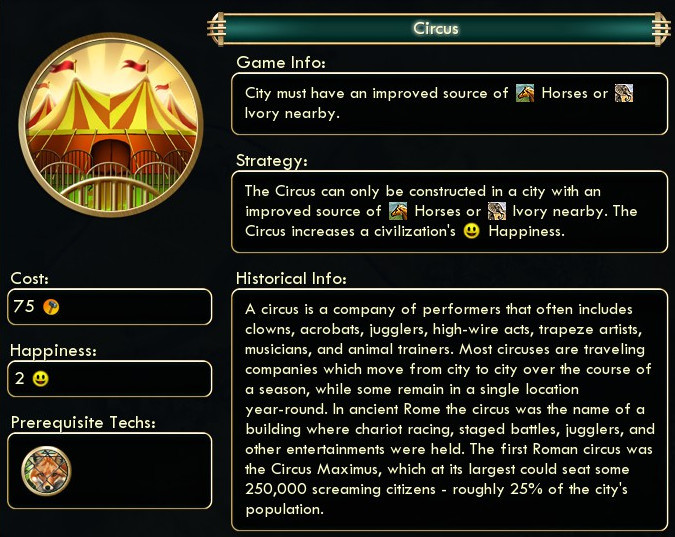
Here we see one of the boons gained from Trapping. The Circus is a building whose construction is predicated on the availability of certain types of resources available to the city, and in our case it will be available in almost any city in this area given the sheer number of Elephants.
Happiness is a global score that decreases with increasing population and number of cities for each Civ, and certain acts of war such as capturing and razing cities. Happiness increases with the construction of certain buildings, access to Luxury Resources, the discovery of Natural Wonders, and factors such as Social Policy or Religion choices. Going below 0 Happiness carries some penalties, including the aforementioned penalties to Combat scores, a sudden cut to Food stores which will slow Population growth, and loss of Production and Gold. In excruciatingly bad cases, it can cause hostile Barbarian units to start spawning randomly inside your borders, or entire Cities to defect to other Civs. Contrariwise, Happiness greater than 0 will add points to a Golden Age counter (visible next to Global Happiness as a yellow diamond shape) which, upon reaching the target number, will give Portugal a Golden Age bonus which increases our Culture, Gold, and Production output for several turns.
To this end, it is important to manage Happiness as the Civ expands or goes to war...

...and expanding is just what I plan to do. With Lisboa's population at 5 and the next growth spurt several turns away, I decide that it is time to build another Settler and place our second City. The notable thing about building Settlers compared to other units is that, while a Settler is built, the population growth process of that city freezes. This is reflective of the idea that the Civ is devoting more time and resources towards developing a potential new population centre, but it can stall growth significantly if certain measures are not taken.
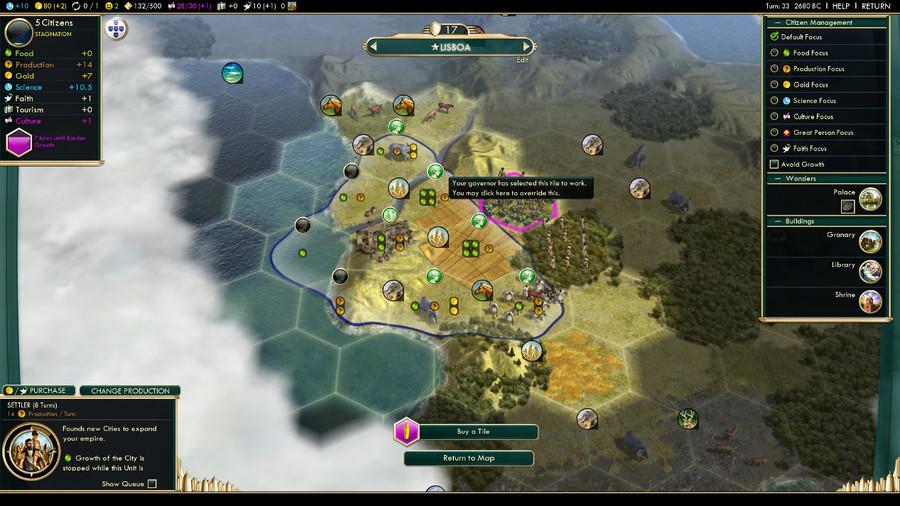
This is where Citizen Management comes into play. Since population growth is not a factor, Food is not as necessary to the city, and it is better to go all-in on Production to ensure that the Settler is available faster and growth can resume. Thus, we move one of our citizens from the Wheat tile...
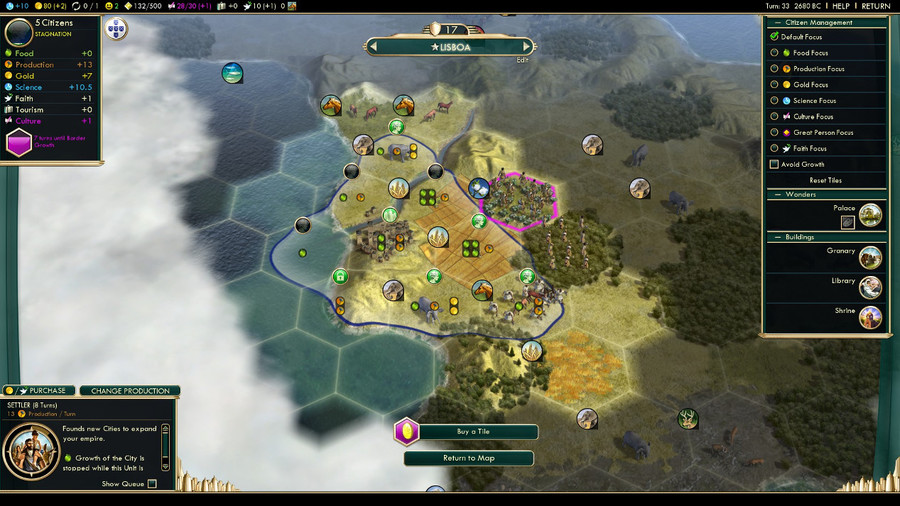
...to the Hills to Lisboa's southwest, resulting in a net loss of 4 Food and a gain of 1 Production, a poor trade under most circumstances that aren't Settler creation (since most tiles are 1 Production tiles, I choose the Wheat because the Elephant tiles also give Gold, which is always nice to have). This does not immediately change the number of turns required to complete the Settler, but I am hoping that this will shave off a turn once the Pasture adds another Production point to the tile with Horses.
(In retrospect, this was the wrong move, as the game calculates Food and converts it to at a rate of approximately 50% for Production for Settler construction, and it would have resulted in a slightly faster Settler build here. Thank you gbuchold for pointing this out)
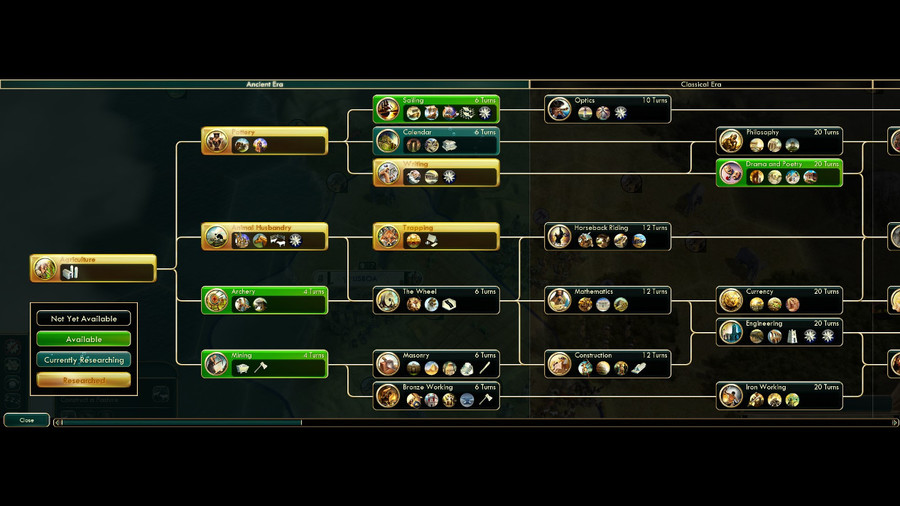
With that, Dona Maria decrees that while the voice of God told her that the people of Portugal must take to the fields and hunt the gargantuan grey beasts of the plains for their meat, a smaller, but no less impassioned dissenting voice told her that they must also take care to track the seasons and the greater passage of time, that they may better understand migratory patterns and the growths of plants that both humans and animals may eat, in order to better prepare for the future.
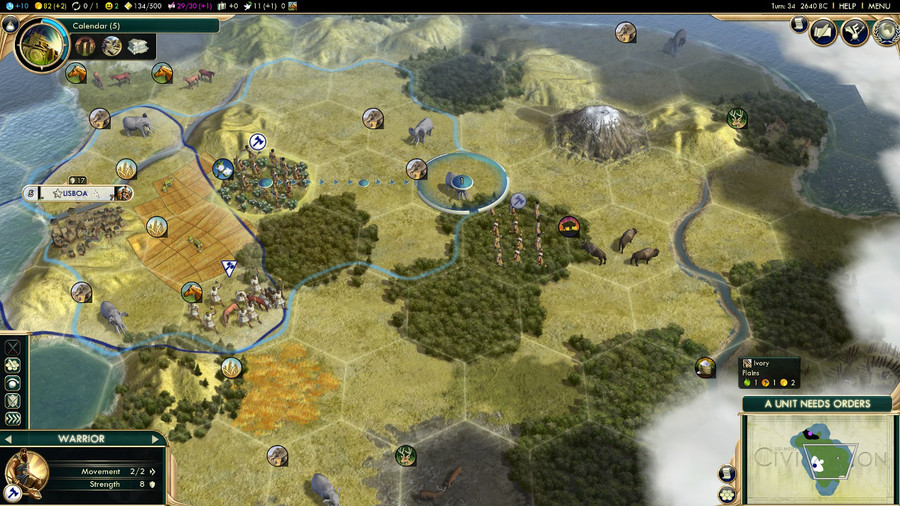
Our two Warriors proceed eastwards to scout the potential location of the new City. There are few barbarians to the immediate east, so it may be a bit of an easier advance than I had originally feared.
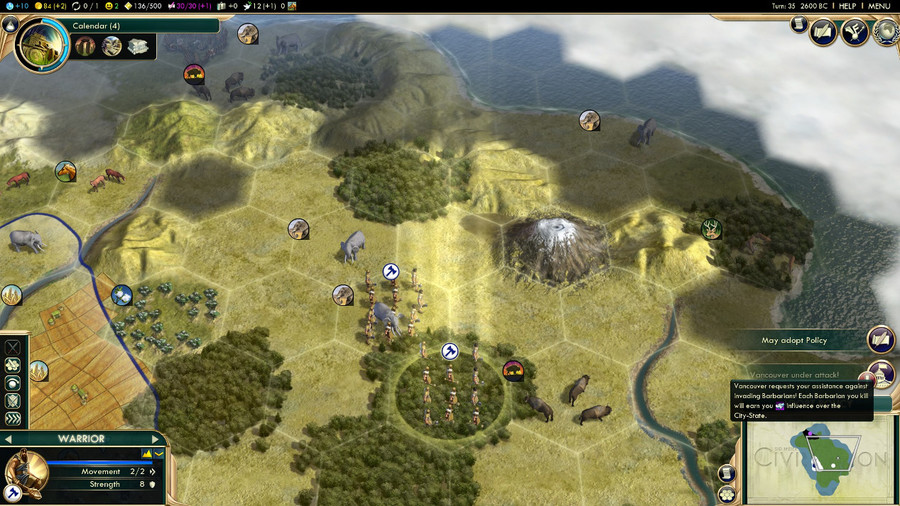
However, the same does not appear to be true to the North, as Vancouver is under siege from more Barbarians, and have requested aid. We are more concerned with the immediate East at this time, however, as we have to make preparations for our Settler.
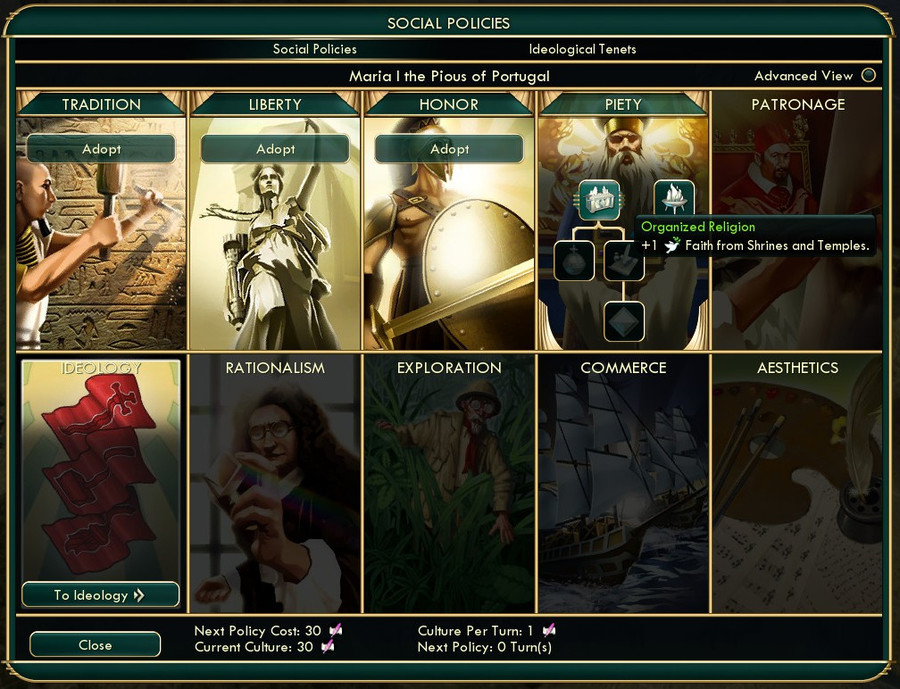
We have also unlocked our second Social Policy, and in the spirit of following through with our earlier demand for Piety, I adopt the immediately useful bonus of Organized Religion, adding +1 to the Faith output of our Shrines and Temples, which functionally doubles our current Faith.
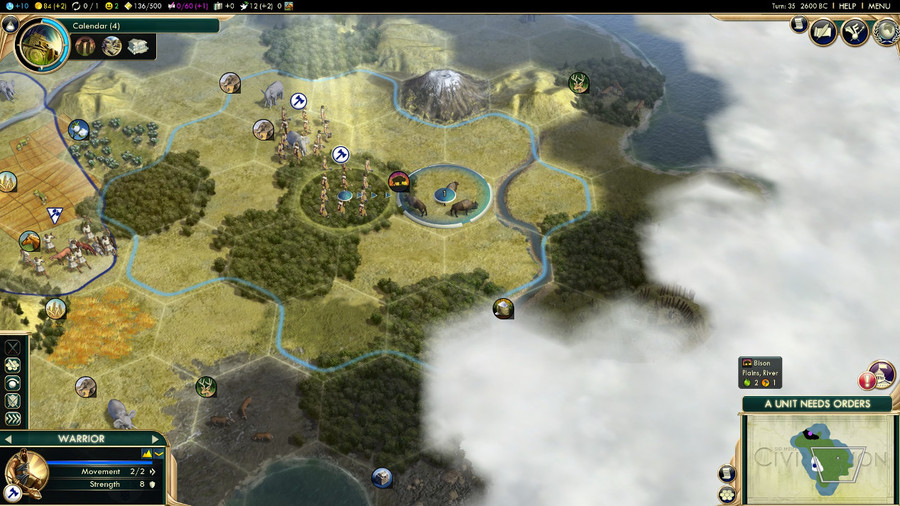
The journey eastwards continues...
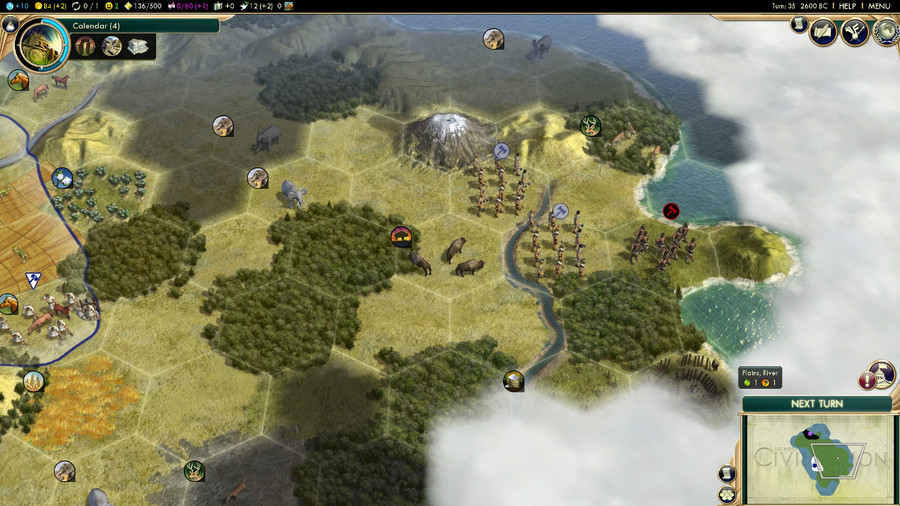
...and we see our next opponent. Given that our more experienced unit is adjacent to him, and our rookie has just climbed Kilimanjaro for a boost, we should have a strong advantage here.
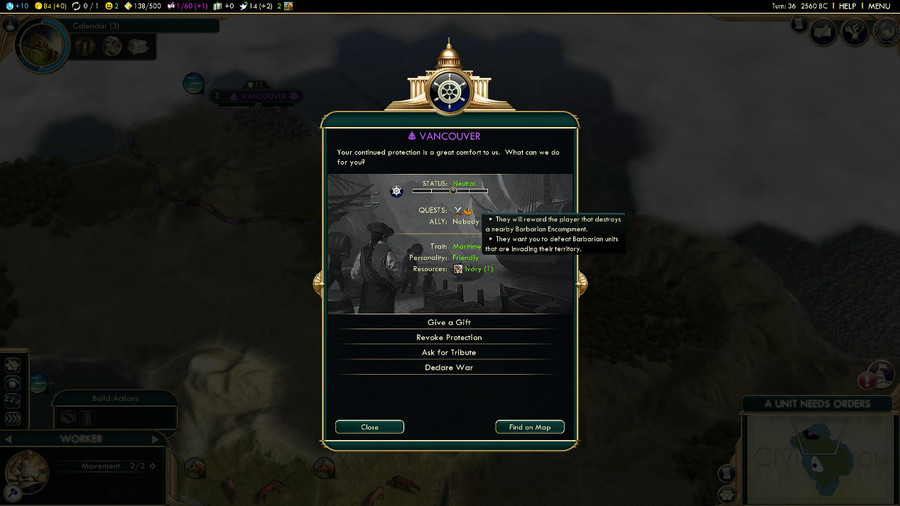
At this time, we will take another look at Vancouver's request, and we see under Quests that we can get bonus Influence with them for eliminating nearby Barbarian units (which we have done previously) and wiping out a specific Barbarian Encampment, which in this case is right next to them. Vancouver, though inconvenienced, is in no real danger of falling to Barbarian units, however, and as such we need not worry about them while there is still work to be done eastwards.
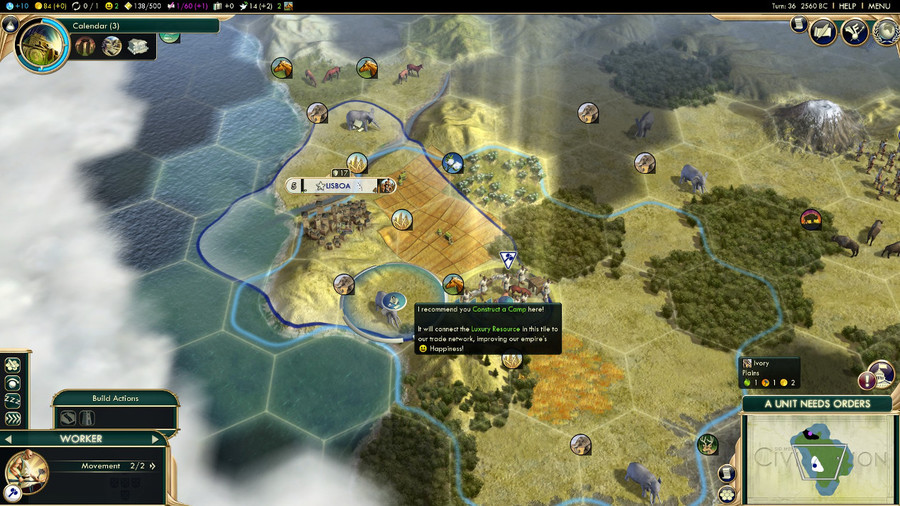
With the Pasture complete, our Worker begins the first hunting Camp, which offers a nice +1 Food and Gold, as well as access to the Ivory Luxury resource for an additional +4 global Happiness. Not too shabby.
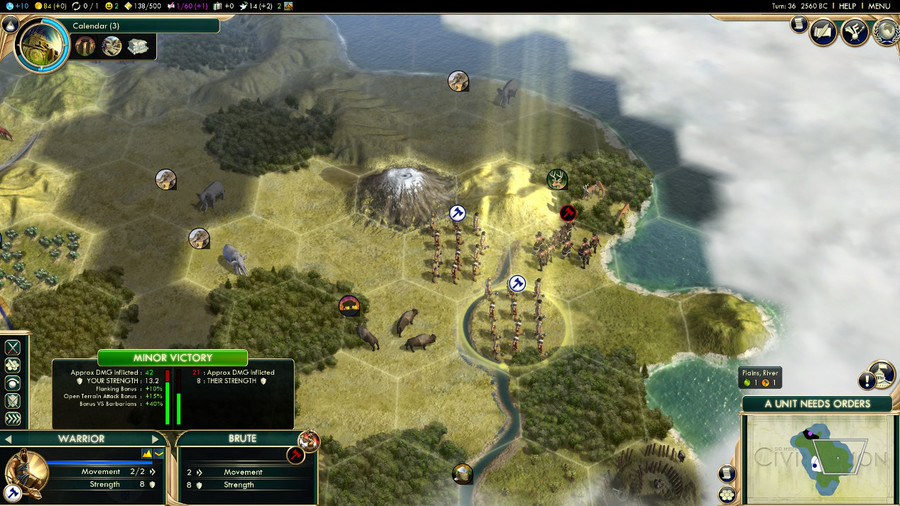
The Brute has moved northwest through our Zone of Control to their current position, and I see a few steps we can take. We have a significant advantage with two strengthened units and our flanking position, but at the same time, the river between the rookie unit and the Brute makes attacking from their position a costlier step than it needs to be, as they will be taking a significant combat penalty by trying to attack across a river.
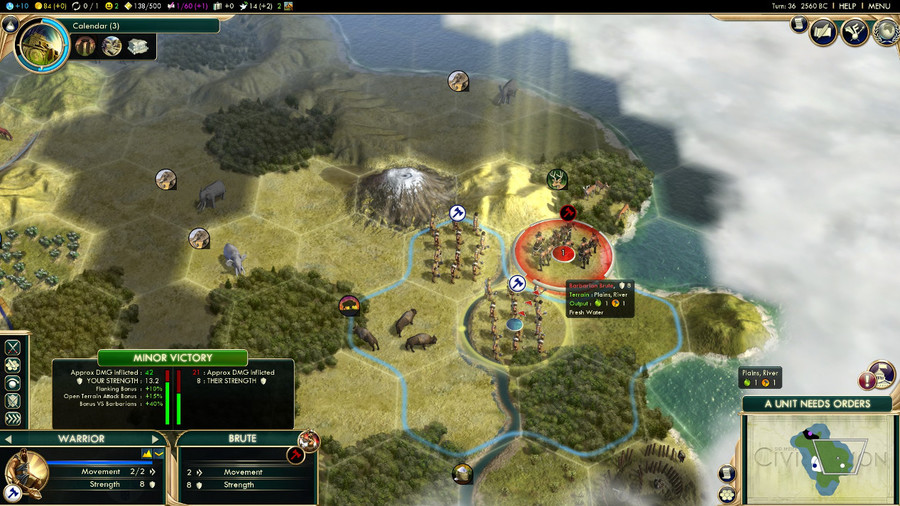
As such, we decide to instead engage the Brute with our more experienced unit first, dealing a significant blow.
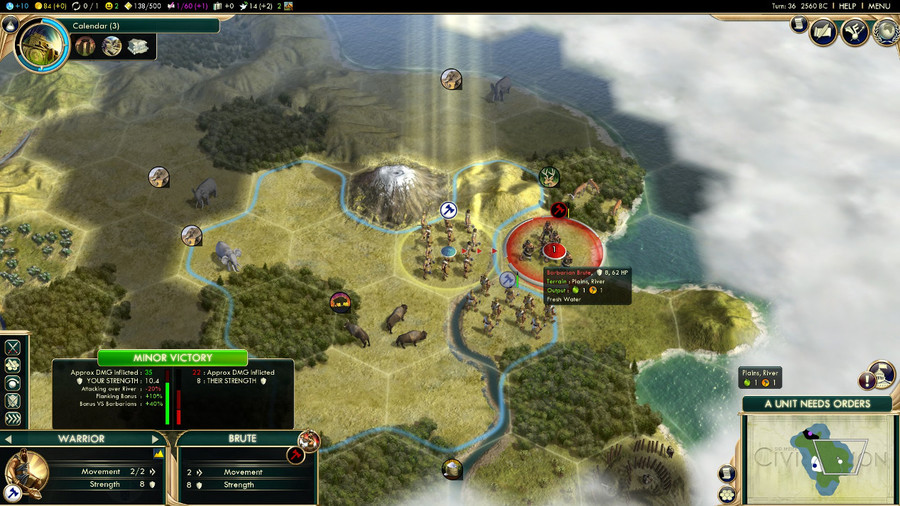
However, rather than take penalties with a second attack...

...we move onto Hills to further restrict their movement northwards. This does not preclude them from attempting to move between both units, but that choice will still leave them at a disadvantage, and I do not mind taking a little extra time to ensure that this job gets done with fewer Portuguese casualties.
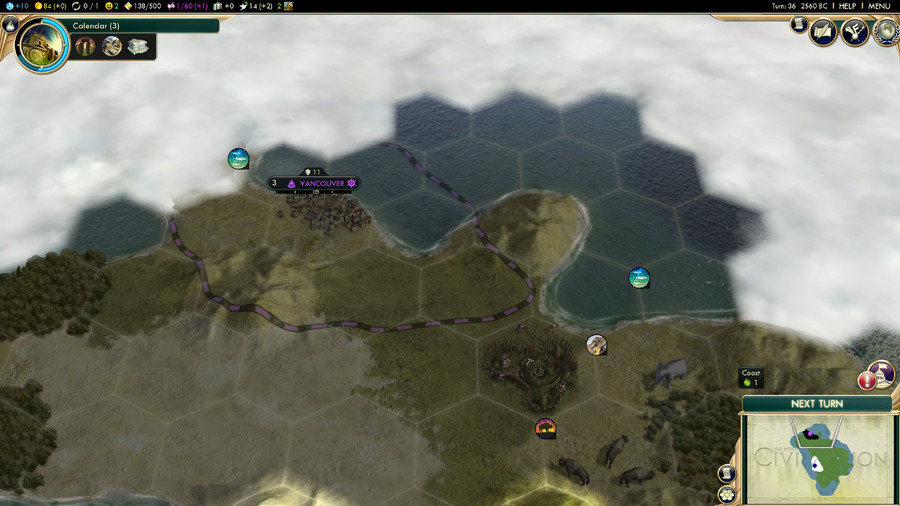
I am sure Vancouver doesn't mind either.
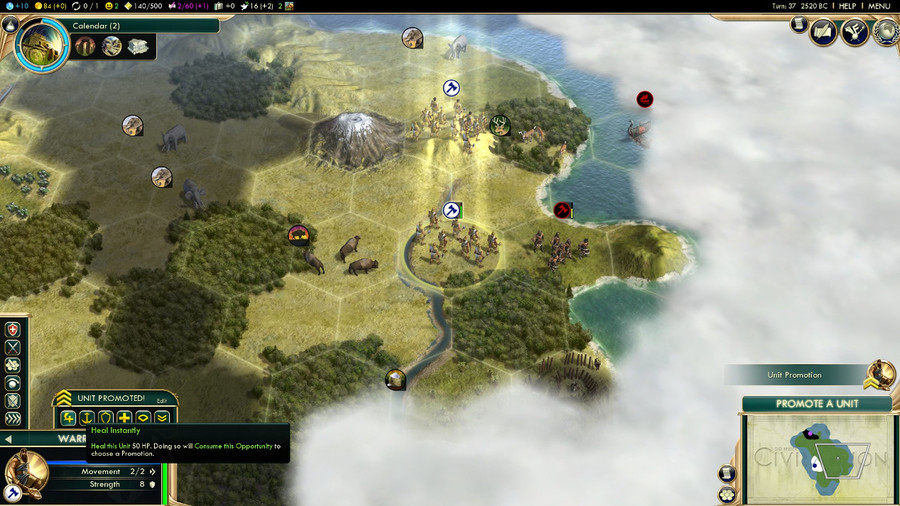
A turn passes, and we are greeted by a shocking sight. The Barbarians have built Galleys, the seafaring equivalent of Brutes, leading to the embarrassing revelation that filthy Barbarians have learned the secrets of sailing before the Portuguese
 . A national (and personal) embarrassment to be sure. It is at this point that Dona Maria resolves to wipe out this mistake of history, and with a further-promoted Warrior on the job, it is already well on its way to being realized.
. A national (and personal) embarrassment to be sure. It is at this point that Dona Maria resolves to wipe out this mistake of history, and with a further-promoted Warrior on the job, it is already well on its way to being realized. For your consideration, here are the promotion options for a Warrior promoted for the second time (I picked Shock I as the first bonus):





I decide to double down on our flat terrain specialization and pick Shock II, though there are numerous very good options in that list for other circumstances.

The Brute has moved southeast to retreat, so the rookie Warrior pursues and the slaughter begins.
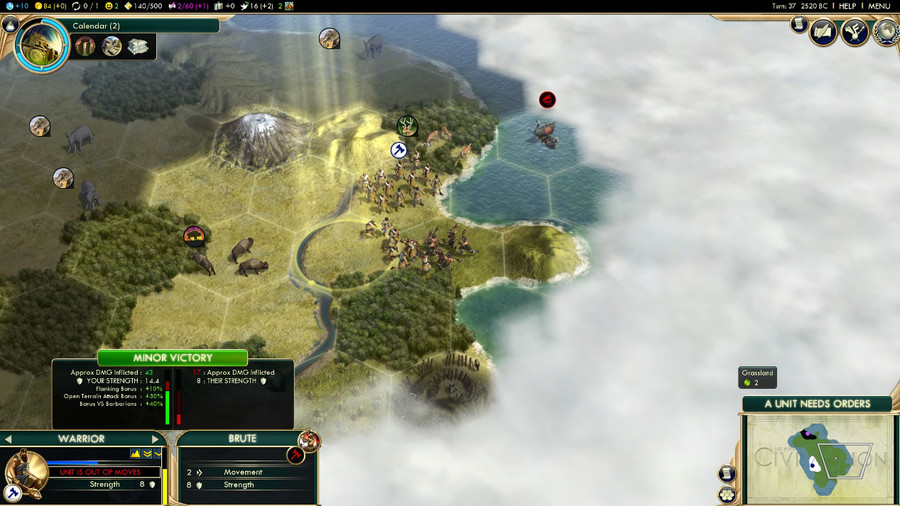
The newly-promoted Warrior wreaks havoc on flat terrain...
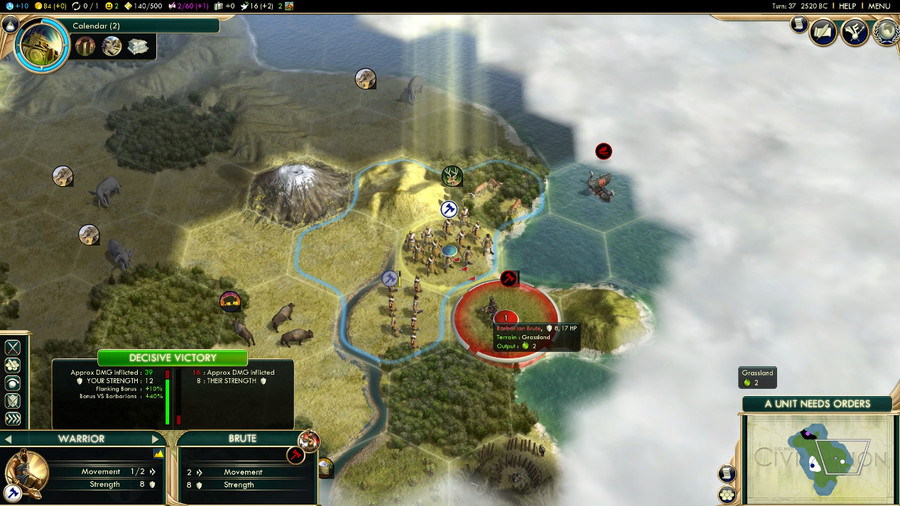
...and the pursuing rookies take the kill.
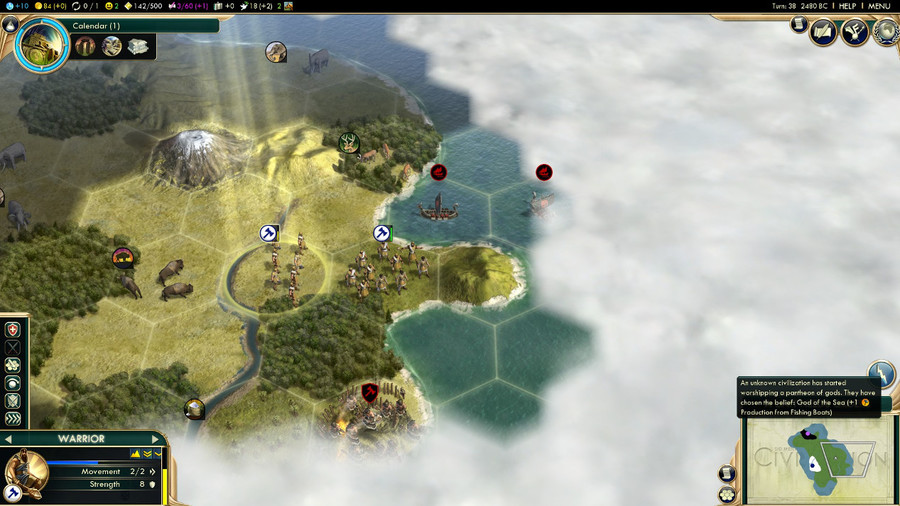
A fine showing by the warriors of Portugal, but as though to mock us, a second Galley comes into view. To pile insult upon insult, it would appear that another Civ has decided to follow the God of the Sea, which under any other sane and rightful circumstances would also go to Portugal in lieu of Goddess of the Hunt

 .
.It is with shame that I must admit that this game is turning out completely unlike any Portugal game I have played thus far, considering our starting layout and available strategies. It is an embarrassment to be sure, but one that I do sincerely hope everyone still enjoys, even if the experience is not as authentic as I would have liked.
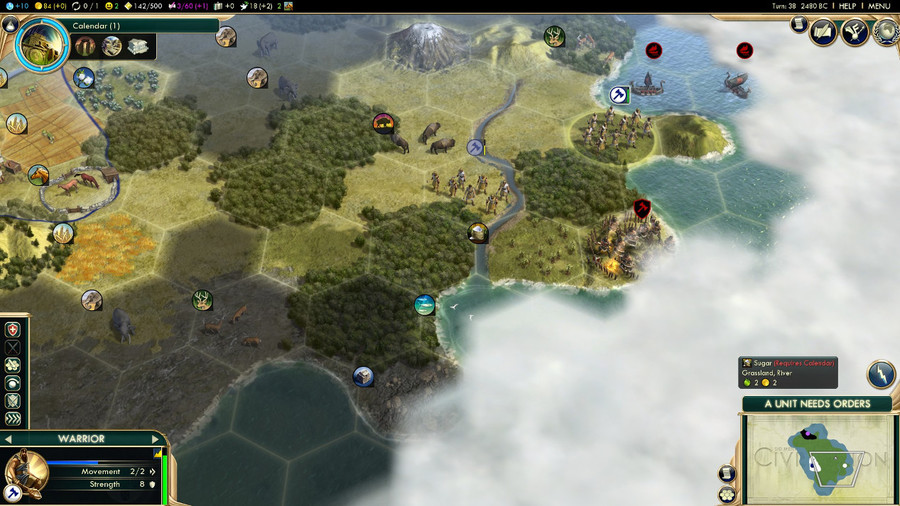
We move the more experienced of the two Warriors southwest to begin encircling the Barbarian Encampment, and it is at this point that I become fully aware of our circumstances:
Note that the tiles just revealed indicate that the Encampment to the southeast is, in fact, on a peninsula.
Note further that the entire east side of this area is coastline.
Gyra_Solune posted:
Also, we may or may not actually be on an island in which us and Vancouver are the only inhabitants and I for one will not stand for spending thousands of years with only Vancouver for company.
I am afraid that your fears have been realized, meu amigo. For the time being, we are isolated and hunting in solitude. The world on this island is all we will know for now.
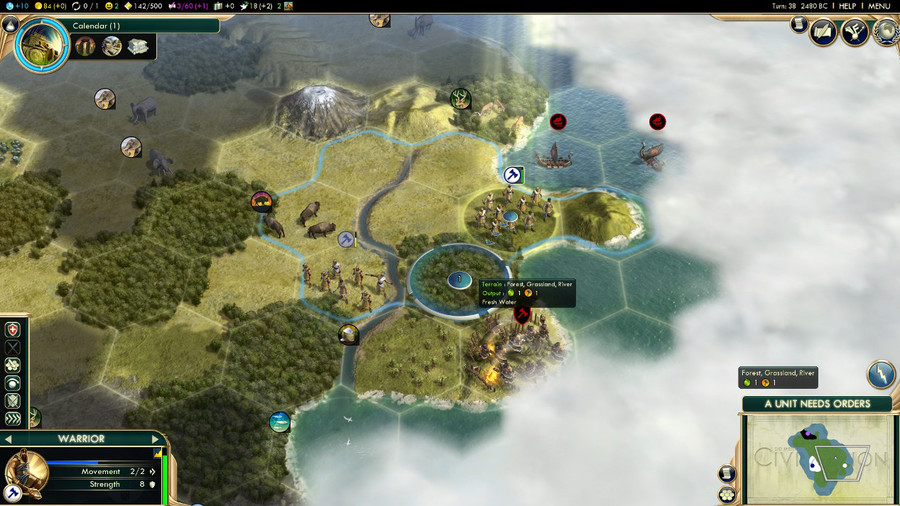
That said, we still have a job to do.
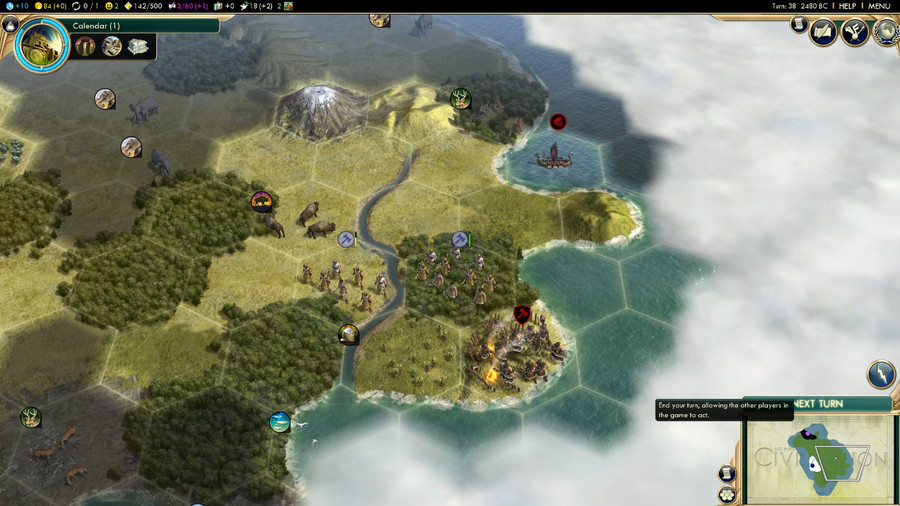
If we are lucky, getting the Warriors into position surrounding the Encampment will prevent them from spawning new units on land, forcing them to instead make more Galleys which are much less direct threats to our Settler (though they are threats to our pride, to be sure).
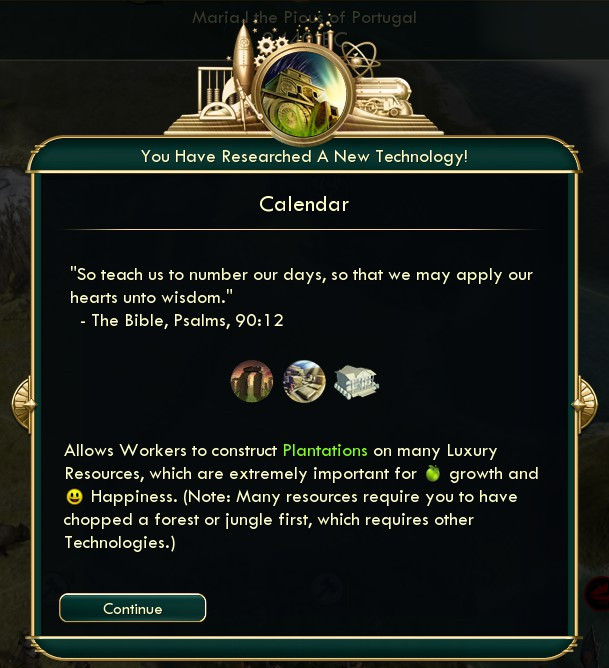
We now know what time it is.
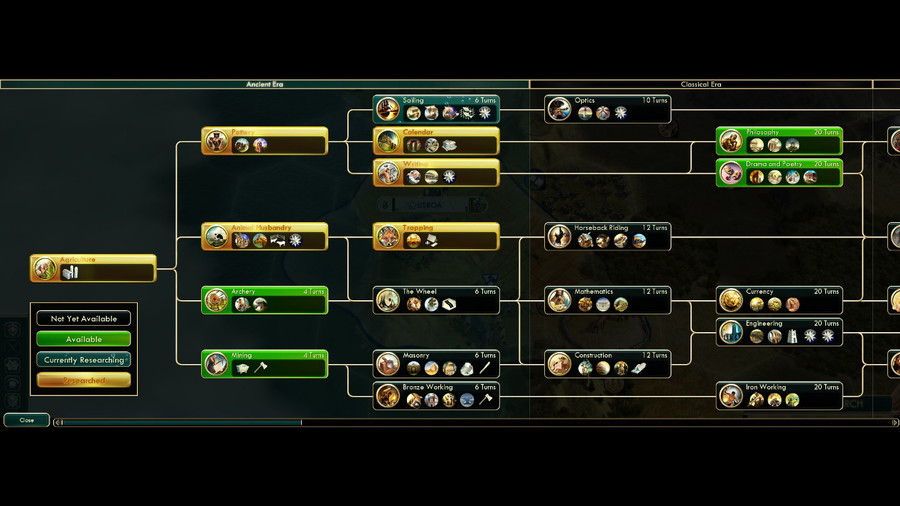
It's time to finally start conquering the sea.
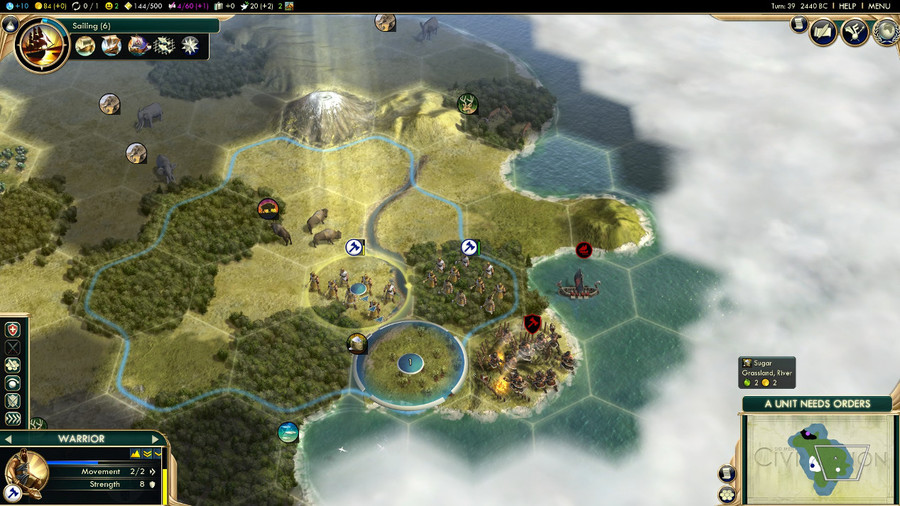
With the more experienced Warrior in position, we are almost ready to clean house. Normally it would be inadvisable to place a unit on a tile containing marshes full of sugarcane, as it gives them a penalty on defence. However, we can be confident that the Brute will not try to attack as they will then lose their fortified position, opening them up to a retaliation they will not survive.
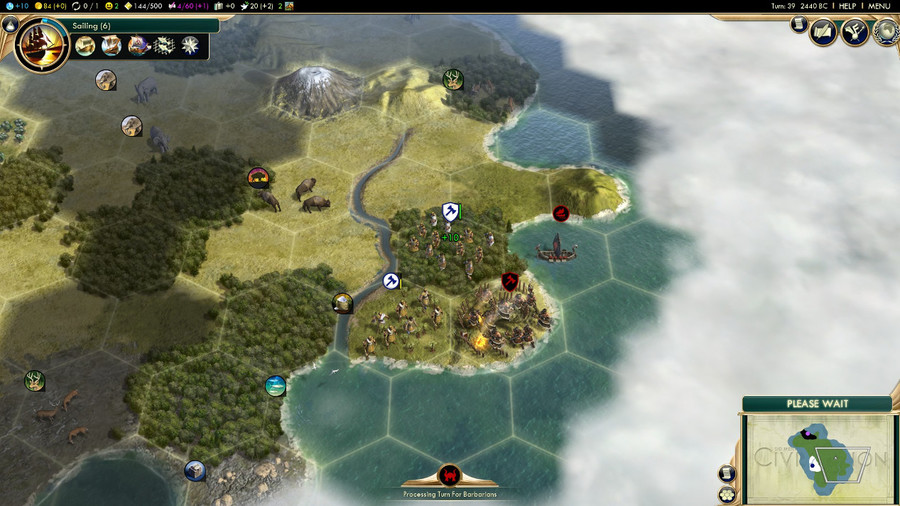
I thus decide to fortify the other Warrior in order to ensure everyone is at full health before moving in.
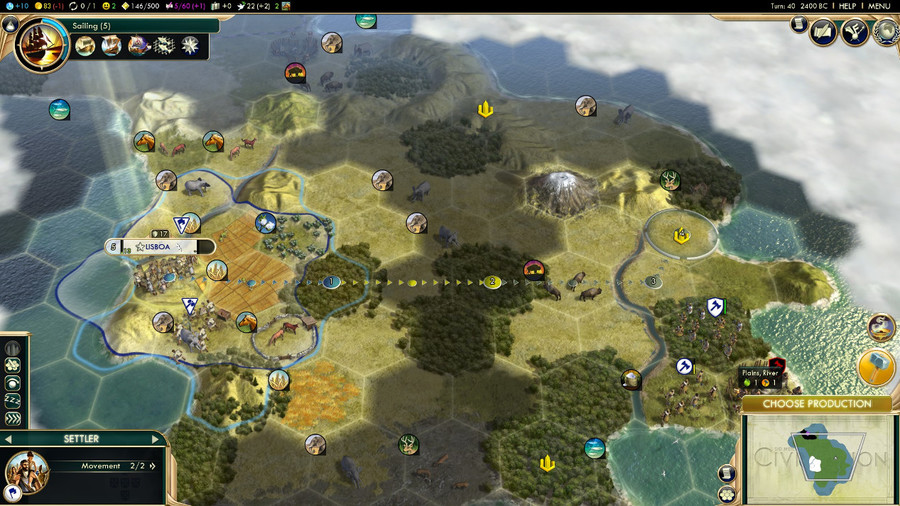
With our next turn, our Settler is complete and ready to move onto a new part of the continent, and one of the spots adjacent to Kilimanjaro seems to be a natural choice. The game itself also uses small city icons (the three towers) when using a Settler to denote good potential city locations, based on immediate and future available resources.
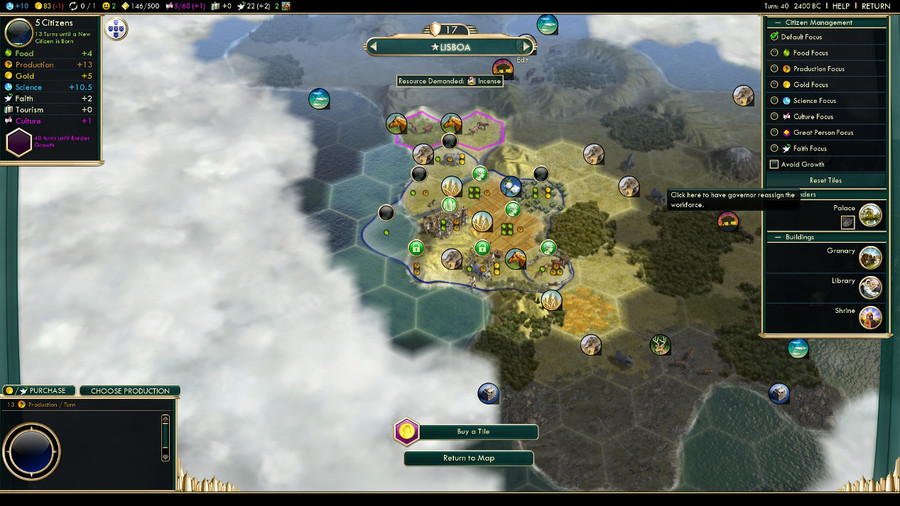
I also use the "Reset Tiles" button in Lisboa's Citizen Management to re-prioritize citizen activity towards food, since the Settler is complete and Lisboa can resume growth.
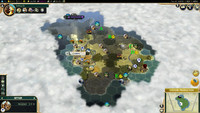
This thumbnail shot will be our State of the Empire, as we now see the near-entirety of our shared island home with the City-State of Vancouver (unless it has been destroyed completely by Barbarians). However, despite what I wrote earlier about our total isolation, it appears that there is some landmass near Vancouver's north border which might not necessarily terminate in a peninsula, meaning that it is possible that ours is the southernmost portion of a larger continent connected near Vancouver's north by a tiny sandbar. The only way to know for sure will be to explore Vancouver's borders more thoroughly when we go to smash the barbarians terrorizing them.
However, in this last picture, I have also indicated in coloured text several points on the map where I believe it makes sense to place our second City. However, this is a matter for the thread to decide, so please indicate where you believe the City should be located. In the interest of informed decisionmaking, here are some example arguments for and against each option.
A - One tile east of the northernmost Elephant:
Pros: Immediate access to elephants and fish, later access to bison, proximity to Vancouver and Lisboa for easier potential trade, immediate surroundings include lots of hills for good production value, location atop a hill provides a production bonus, coastal city for access to ships.
Cons: Relative dearth of resources beyond those first three, no access to Kilimanjaro tile. Little growth potential beyond lots of Production.
B - Two tiles directly northwest of Kilimanjaro. Recommended by game #1:
Pros: Eventual access to Kilimanjaro and 4 elephants bison, and Fish, hilltop location provides a production bonus, coastal city, proximity to Vancouver and Lisboa for easier potential trade.
Cons: No immediate resource access, will have to wait a significant time or buy lots of tiles to access resources sooner, little growth potential beyond access to Kilimanjaro and lots of available Production.
C - One tile east of Kilimanjaro:
Pros: Immediate access to Kilimanjaro and deer, eventual access to 3 elephants and 1 bison, location atop a hill provides a production bonus.
Cons: Out of reach of the Sugar resource to the south, out of reach of the river to the south, preventing access to some buildings, inland, and will thus be unable to build boats or coast-specific buildings.
D - One tile southeast of B. Recommended by game #2:
Pros: Immediate access to deer, eventual access to Kilimanjaro, Bison, Sugar and 2 elephants, coastal and river-adjacent city enables production of ships and certain buildings.
Cons: Out of reach of 1 elephant and elephants in general will require more time to access, general lack of nearby hills beyond ones adjacent to Kilimanjaro will result in lowered production.
E - Southeast coastal forest tile. Recommended by game #3:
Pros: Immediate access to deer, stone, and fish, eventual access to 1 elephant and sugar, eventual shared access to wheat with Lisboa, coastal city, proximity to Lisboa for easier trade.
Cons: Proximity to tundra, which is a low-yield tile, no river- or hill-based benefits, no access to Kilimanjaro tile, lack of hills or horses mean low production in the long term.
With that in mind, the thread is more than welcome to suggest options beyond the ones identified, provided you can identify for which tile I should aim (try to use a spatial reference point like "one tile southeast of Kilimanjaro" or "one tile southwest of southernmost elephants"). These will be options "F", "G" and so on provided you identify them as such.
Note that not all of those choices are mutually exclusive, as the only rule for City creation is that it cannot be within 4 tiles of another City, so it will be possible to fit 2 cities into the explored area given enough time.
Also, our new city will need a name, so give our new city a name! Given that we are in a tropical land full of elephants and plains, I will opt to suggest the name of a Portuguese colony in Angola, which was called Luanda. That said, the most voted-for choice will be the one chosen.
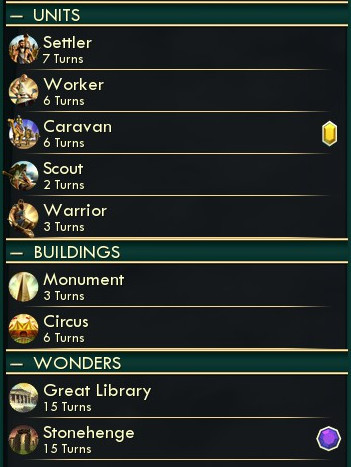
However, if that still isn't enough, you will also be deciding the next production project in Lisboa! These options represent the ones immediately available, and since Sailing is five turns away we will eschew the option of building boats for now. Pick any option from the list above and I will try to see it through, but here are my recommendations:
Worker: Always handy to have more, especially to help build up a new city.
Caravan: We start trading sooner to get the most out of Mare Clausum with Vancouver so close by, results in start of our trade game.
Monument: Time to get our culture game on the road, -1 Gold +2 Culture.
Circus: More Happiness will be a plus, especially once it takes a hit when we build our new City.
Stonehenge: The best early-game Faith boost production can buy, this Wonder will give +5 Faith per turn for the rest of the game, and points towards the creation of a Great Engineer. This is huge and the best demonstration of Portuguese devotion, but also a massive risk as someone else may have started building it already, and only the first to finish gets it.
Per usual, I will close the vote in 2 days, so get those votes in before Friday at 7 PM Eastern and see your will exercised upon the Empire of Portugal!
Boa noite!